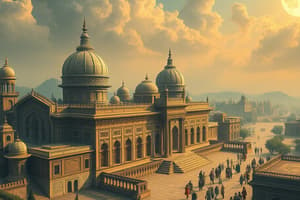Podcast
Questions and Answers
What was a significant feature of urban planning in the Indus Valley Civilization?
What was a significant feature of urban planning in the Indus Valley Civilization?
- Grid patterns and sophisticated drainage systems (correct)
- Use of non-standardized building materials
- Circular street layouts with random house placements
- Buildings lacked multiple stories
Which of the following reflects the main basis of the Indus Valley Civilization's economy?
Which of the following reflects the main basis of the Indus Valley Civilization's economy?
- Predominantly industrial production of textiles
- Extensive maritime trade as a primary activity
- Heavy reliance on nomadic herding practices
- Agriculture focusing on crops like wheat and barley (correct)
What distinguishes the script of the Indus Valley Civilization?
What distinguishes the script of the Indus Valley Civilization?
- It was primarily an oral tradition with no written form
- It includes numerous bilingual texts from other civilizations
- It is fully deciphered and widely understood
- It remains undeciphered due to the absence of key texts (correct)
Which type of artifacts suggests religious practices in the Indus Valley Civilization?
Which type of artifacts suggests religious practices in the Indus Valley Civilization?
What is debated among scholars regarding the decline of the Indus Valley Civilization?
What is debated among scholars regarding the decline of the Indus Valley Civilization?
Which feature of the Indus Valley Civilization's architecture is most notable?
Which feature of the Indus Valley Civilization's architecture is most notable?
How did the Indus Valley Civilization influence later cultures in South Asia?
How did the Indus Valley Civilization influence later cultures in South Asia?
What type of craftsmanship is the Indus Valley Civilization particularly renowned for?
What type of craftsmanship is the Indus Valley Civilization particularly renowned for?
Flashcards are hidden until you start studying
Study Notes
Overview of the Indus Valley Civilization
- Flourished from approximately 2500 BCE to 1900 BCE in northwestern South Asia, covering present-day Pakistan and northwest India.
- Also known as the Harappan Civilization, recognized for its significant urban culture and advanced societal structures.
Urban Planning
- Cities like Harappa and Mohenjo-Daro featured organized layouts with grid patterns.
- Advanced drainage systems and standardized fired-brick construction were integral to urban design.
- Residential buildings exhibited a uniformity in brick size and street arrangement.
Architecture
- Featured notable structures such as the Great Bath of Mohenjo-Daro, indicating sophisticated public amenities.
- Included granaries and warehouses, with buildings typically rising two to three stories in height.
Economy
- Primarily agrarian, with cultivation of wheat, barley, and cotton.
- Engaged in trade with surrounding regions, notably Mesopotamia, exchanging items like beads, metals, and textiles.
Writing System
- Utilized an undeciphered script, evident from numerous seals and inscriptions.
- Lack of bilingual texts poses challenges for understanding the language and writing structure.
Art and Craftsmanship
- Known for skilled artisanship, producing pottery, jewelry, and figurines.
- Intricate seals often featured animal motifs and were likely used for trade or administrative functions.
Religion and Culture
- Evidence of potential worship practices focused on fertility deities and proto-Shiva figures, though much remains speculative.
- Rich artistic tradition displayed through terracotta figurines and decorative seals.
Decline
- The decline around 1900 BCE remains a topic of scholarly debate.
- Possible contributing factors include climate change, alterations in river patterns, resource depletion, and potential incursions by other groups.
Legacy
- Established foundational practices for future South Asian cultures, influencing urbanization and agriculture.
- Remains an area of significant archaeological research, contributing critical insights into early human civilization and social organization.
Studying That Suits You
Use AI to generate personalized quizzes and flashcards to suit your learning preferences.




